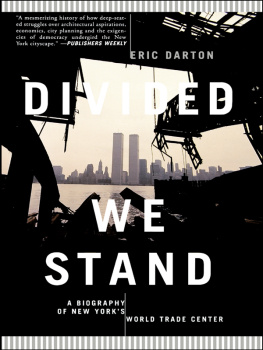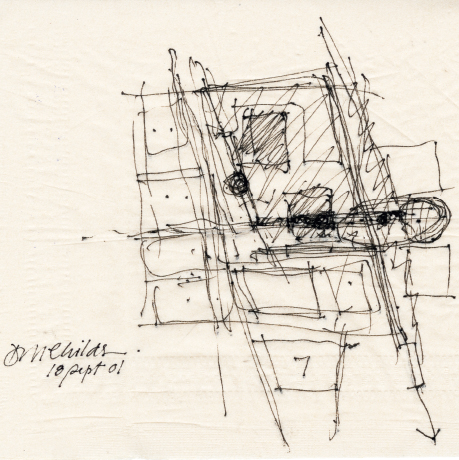A sketch made a week after September 11 shows architect David Childs divining how to organize the newly devastated site. He drew as he discussed potential solutions with Geoff Wharton of Silverstein Properties. This prescient document confirms the Twin Towers footprints as the sites center of gravity and the importance of reinstating Greenwich and Fulton streets. Seven World Trade Center, marked 7, is a given; dark circles indicate where additional buildings could be located in the future. Right: Childss note to his right hand, Jeff Holmes, imagines a tower even taller than the one proposed.
One World Trade Center, the tallest building in the Western Hemisphere, is the most advanced skyscraper ever constructed. A structural and political tour de force, it is the triumphant result of many demands, hopes, and visions that came together, improbably and at great cost. Now, as the new World Trade Center moves from a place of great debate to a great place, this book responds to the intense curiosity from around the globe about how this remarkable supertower was designed and built. The answers might surprise you and undoubtedly will inspire you.

The tower was a monumental undertaking, an outsized presence on the world stage and in the nations collective psyche. After September 11s devastation and the warping disequilibrium and heartache that followed, simply deciding whetherand whatto build required the foresight of a dedicated few, the expertise of thousands, and the goodwill of a nation. These efforts can be understood only in the context of the larger site, where grief and contention have given way to enormous vitality. That liveliness is expressed in a plethora of building typesskyscrapers, certainly, but also a memorial, a museum, a church, a transit center, bridges, a plaza, a park, and stores. The World Trade Center is a new city within the city.
Nearly every state in the nation participated, contributing materials and skills to the rebuilding of the largest, most visible architectural project in memory. Each beam, rafter, and bolt was placed on behalf of the American people, and every construction milestone was accompanied by the raising of an American flag. One World Trade Centers staggering statistics reflect what it took to build it: Its superstructure consumed 45,000 tons (408,023.3 metric tons)ninety million poundsof structural steel, ninety percent of it recycled. Its central core was cast in concrete, some of it as strong as 14,000 psi (96.5 MPa), the strongest ever used in a skyscraper and just part of the 208,000 cubic yards (159,027.4 m3) of concrete that went into its making, enough for a sidewalk stretching from New York to Chicago. One million square feet (92,903 m2) of crystal-clear glassthe safest, most sustainable, and largest panels ever to clad a skyscrapercover its upper reaches. Five of the fastest elevators in the Americas whisk visitors to its sky-high observatory. The project also took human effort, guzzling workers talent, muscle, and willpower like a hungry animal. More than 26,000 workersup to 3,500 of them daily, representing the expertise of forty-nine unionshave worked at the Trade Center since 2001. For many years, the Port Authority of New York and New Jersey was the single largest contributor to construction spending, Patrick J. Foye, the agencys executive director, said. Thats a lot of jobs.
Exceptionally strong and secure, One World Trade Center is a nuanced response to security demands made on cities everywhere since 9/11. It was designed by Skidmore, Owings & Merrill LLP (SOM), a firm with unparalleled expertise in skyscraper design. Pioneering building technologies and life-safety methods that were first developed for Seven World Trade Center, also designed by SOM, were refined and expanded at One. Innovations at both buildings helped rewrite the New York City Building Code, which had been essentially moribund since 1968. Long before tenants arrived, One was a working building, providing benchmarks for structural design, blast mitigation, and construction sequencing that are now used worldwide. Together, the designers, engineers, and owners even managed to change the way New York unions erect skyscrapers: the tower has a rigid structural steel perimeter as well as a reinforced concrete core. That core is the most significant technological leap forward in how buildings in New York City are designed today.


















